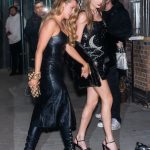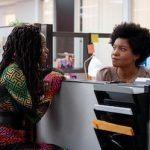In the 1970s, you were a trailblazing Black fashion model. In the ’80s, you became a modeling agent and launched your own agency. All the while, you’ve been championing racial diversity in the fashion business. Now you’ve codirected Invisible Beauty, a documentary autobiography, with Frédéric Tcheng. How did you come up with the title?
I had that title for a long time. Originally, this film was an exposé on the fashion industry. It might have come up because the novel Invisible Man (by the African American writer Ralph Ellison), back in the day, was a big thing. When Frédéric and I thought to collaborate, I told him about that title, even though I had decided to let the film be about me instead. He asked me to come in as a codirector.
You’ve been a co–executive producer on TV shows, including Between Brothers, starring your son, Kadeem. Did that prepare you for this experience of codirecting a film about yourself?
Nothing prepares you for that. What I really had to do was get out of my own way. I needed to stop thinking that I had no story.
You thought you had no story? This sounds like modesty, coming from someone who has received the Founder’s Award in honor of Eleanor Lambert from the Council of Fashion Designers of America for your advocacy work.
If you’re really a soldier, it’s different; you’re just busy doing the work. But to actually make a story out of that, that somebody wants to watch?
In making this film, you must have seen some old footage of yourself for the first time. What was that like?
At a certain age in life, I started to give the fashion industry much more credit about race. I would say things like, “I think that they’re more ignorant than anything.” But then I see the film and there’s an old close-up of me saying, “Racism is alive in fashion.” And that took me aback because I don’t remember having that attitude about it. It makes you realize how militant you might have been, and how much you had to call people out and have no shame about it.
Who would you cite as inspirations or templates?
All the elders. For me, it was Harriet Tubman and Sojourner Truth, because I had no…. I was represented by a white modeling agency, and I was a woman of color. Starting my own agency wasn’t something I desired. People kept pushing me to do it.
Why were they pushing you? What did they see?
I had worked as an agent at Click Model Management, where I helped change the game when it came to the look of models. Then someone reached out to me from Paris, asking if I could open up an agency with her in New York. I said yes, thinking, Okay, I’ll go out and have it be a partnership—but then I learned that she had no intention of keeping me on as a partner. I had walked out of Click already. I had found this great space down in TriBeCa. I basically had no choice. The models really wanted to come with me, so I had this obligation to step up.
Are there any similarities between working as a runway model and running a modeling agency? Did one career prepare you for the other?
The industry that actually honed my skills was the garment business. For many, many years, as a model, I was the girl who did everything that pertained to the design house: I did the runway, fittings, showroom. I was trained by one company after another how to do the most basic things. On top of it, I always had a full-time job when I modeled—I couldn’t afford not to, mentally—so I knew a lot of office stuff.
In 1988, with Iman, you launched the Black Girls Coalition. How do you look at that now?
I gathered all these wonderful girls who were at different agencies, so they could support each other. It had never happened in the history of modeling that Black girls were being featured so prominently in magazines.
What’s the most important thing you’ve done to help educate the industry?
In 2013, I was sick and tired of how, no matter how much diversity work we had done, it kept sliding back. And out of pure frustration, I wrote a letter to the fashion councils of New York, London, Milan, and Paris, indicating that if they continued to use just one or no Black models, no models of color, no matter the intention, the result was racism. That had an immediate reaction.
In recent years, you’ve served as a member of the Gucci Changemakers and as the executive adviser for global equity and cultural engagement at Gucci. How do you define that work?
They brought me in just to keep my eye on things and see if I ever thought anything was out of line. They knew I was the kind of person who would tell them, whether they wanted to hear it or not. I was a big Gucci fan from back in the day, when they would close their New York flagship store in the afternoon to maintain the Italian culture and give their people two hours for lunch. I remember when I saw that, I thought, This is next level.
Photo assistants: Salah Bouade, Youness Bachiri.



